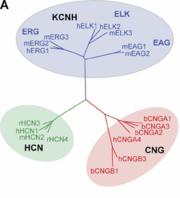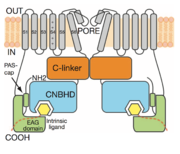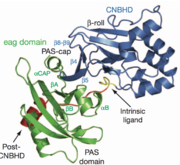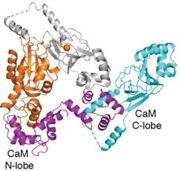Eag domain-CNBHD complex of the mouse EAG1
From Proteopedia
Introduction:
|
They play a crucial roles in repolarization of cells to their resting state and in various diseases such as cardiac long QT syndrome type 2 (LQT2)[1], epilepsy[2], schizophrenia[3] and cancer[4]. The KCNH channels family has unique intracellular domains that distinguish them from other voltage-gated channels. The amino terminal contains an eag domain and the C-terminus contains a cyclic nucleotide binding homology domain (CNBDH).
Intracellular domain structure of KCNH1 (mEAG):
KCNH channels have two intracellular domains that provide the unique properties of regulation and gating to this channel family. The CNBHD (residues 517-698) located on the C-terminus, however dose not bind cyclic nucleotides and regulates gating in unknown mechanism. The eag domain (residues 1-136) composed of a PAS domain (110 amino acid) and highly conserved PAS-cap (25 amino acid)[5]. The eag domain regulates the activation and inactivation in unknown mechanism[6]. The interface between the eag domain and the CNBHD is with an average buried solvent-accessible surface area of ~ (1,400 A ̊2)[7]. The interface consists of three sub-regions: (1) the intrinsic ligand motif of the CNBHD interacts with the aB-helix in the PAS domain; (2) the bA and bB strands of the PAS domain interact with the post-CNBHD segment of the CNBHD; and (3) an amphipathic helix (aCAP) in the PAS-cap domain forms an inter- action with the b-roll of the CNBHD[7]. The post CNBHD region has been shown to mediate the regulation of the channel by variety of cell signaling mediators, including phosphorylation, kinases and Ca2+-calmodulin[8],[9],[10]. The interaction between the eag domain and the post-CNBHD region suggests that KCNH channel regulation through the post-CNBHD region may involve its interaction interface with the eag domain[7].
Ca2+ Calmodulin (CaM) inhibition:
CaM is a multifunctional intermediate calcium-binding messenger protein expressed in all eukaryotic cells, and the binding of Ca2+ is required for its activation[11]. CaM binds EAG in the presence of Ca2+ and inhibits ion conduction[12],[13]. The mechanism is not fully understood. CNBHD – PAS domain complex has 3 CaM contact regions witch form 2 binding sites[13]. Two contact regions at the C-terminus of the CNBHD form 2 α-helices that act as a claw to grab the CaM C-lobe. The linker that connect the two lobes of CaM is very flexible thus he can break and allows the hydrophobic core of the CaM N-lobe to bind a helix on the PAS domain[14].
Disease:
The eag domain-CNBHD complex interface servers as a hot spot for many mutation associates with cancer and LQT2 (hERG).
Therapeutic potential:
The unique intracellular domains of KCNH family may be an orphan receptor. By finding ligands we may able to regulate these channels and stop these devastating conditions.
- ↑ Sanguinetti, M. C. & Tristani-Firouzi, M. hERG potassium channels and cardiac arrhythmia. Nature 440, 463–469 (2006).
- ↑ Zhang, X. et al. Deletion of the potassium channel Kv12.2 causes hippocampal hyperexcitability and epilepsy. Nature Neurosci. 13, 1056–1058 (2010).
- ↑ Huffaker, S. J. et al. A primate-specific, brain isoform of KCNH2 affects cortical physiology, cognition, neuronal repolarization and risk of schizophrenia. Nature Med. 15, 509–518 (2009).
- ↑ Camacho, J. Ether a` go-go potassium channels and cancer. Cancer Lett. 233, 1–9 (2006).
- ↑ Morais Cabral, J. H. et al. Crystal structure and functional analysis of the HERG potassium channel N terminus: a eukaryotic PAS domain. Cell 95, 649–655 (1998)
- ↑ Gustina, A. S. & Trudeau, M. C. HERG potassium channel regulation by the N-terminal eag domain. Cell. Signal. 24, 1592–1598 (2012)
- ↑ 7.0 7.1 7.2 Haitin, Y., A.E. Carlson, and W.N. Zagotta. 2013. The structural mechanism of KCNH-channel regulation by the eag domain. Nature
- ↑ Cherubini,A.etal.Humanether-a-go-go-relatedgene1channelsarephysically linked to b1 integrins and modulate adhesion-dependent signaling. Mol. Biol. Cell 16, 2972–2983 (2005)
- ↑ Sun,X.X.,Hodge,J.J.,Zhou,Y.,Nguyen,M.&Griffith,L.C.Theeagpotassium channel binds and locally activates calcium/calmodulin-dependent protein kinase II. J. Biol. Chem. 279, 10206–10214 (2004)
- ↑ Ziechner,U.etal.Inhibitionofhumanethera`go-gopotassiumchannelsby Ca21/calmodulin binding to the cytosolic N- and C-termini. FEBS J. 273, 1074–1086 (2006)
- ↑ Stevens FC (1983). "Calmodulin: an introduction". Can. J. Biochem. Cell Biol. 61 (8): 906–10
- ↑ Schonherr R, Lober K, Heinemann SH. Inhibition of human ether a go-go potassium channels by Ca(2+)/calmodulin. EMBO J. 2000;19:3263–3271
- ↑ 13.0 13.1 Ziechner U, et al. Inhibition of human ether a go-go potassium channels by Ca2+/calmodulin binding to the cytosolic N- and C-termini. FEBS J. 2006;273:1074–1086
- ↑ Jonathan R., Whicher Roderick MacKinnon. Structure of the voltage-gated K+ channel Eag1 reveals an alternative voltage sensing mechanism. Science. 2016 Aug 12; 353(6300): 664–669




